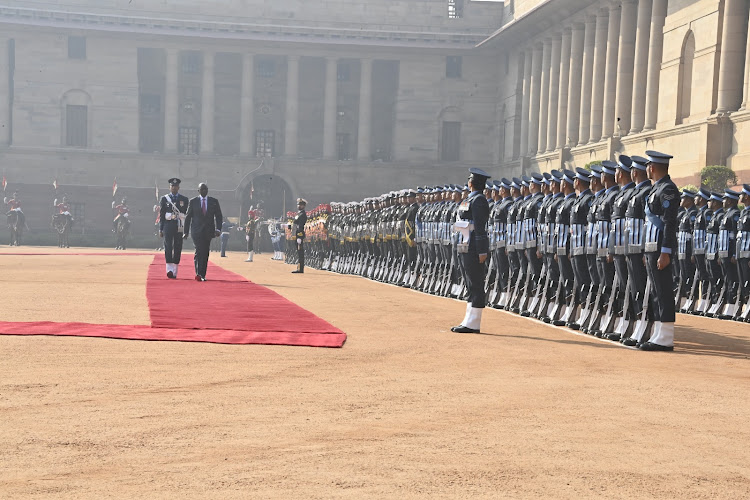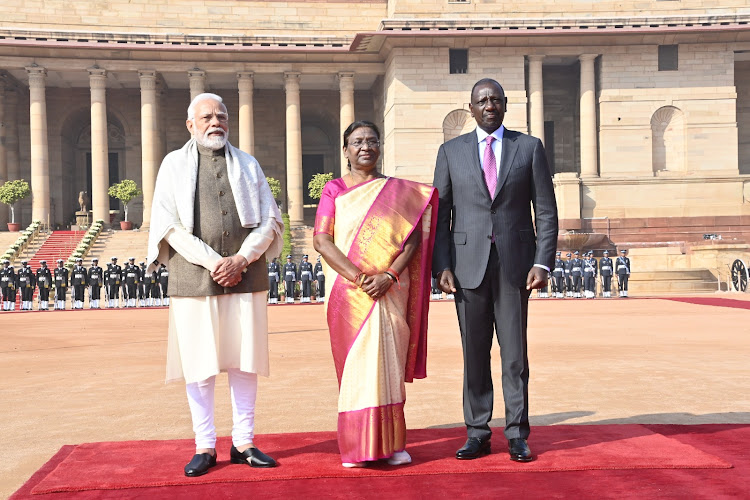Marks Milestone in Kenya-India Collaborative Bilateral Relations
In a historic visit, Kenyan President William Ruto and Indian Prime Minister Narendra Modi have elevated diplomatic ties between their nations, signing five Memorandums of Understanding (MOUs) spanning crucial sectors such as trade, agriculture, security, education, and the digital economy.
The agreements were a centerpiece of President Ruto’s three-day state visit to India, emphasizing the strengthening of bilateral relations and fostering collaboration on matters of mutual interest. Prime Minister Modi expressed confidence that Ruto’s visit would not only enhance ties between India and Kenya but also inject new momentum into India’s engagement with the African continent.

Image: PCS
Agriculture Loan to Modernize Kenyan Agriculture:
India extended a $250 million Line of Credit to Kenya to modernize its agricultural sector, with both nations committing to sharing experiences and increasing partnership in innovation and technology. Prime Minister Modi emphasized the collaboration’s significance, stating, “We have agreed to deepen our cooperation in the agriculture sector. Our farmers can learn a lot from each other.”
The MOU outlined Kenya’s offer of land to Indian companies and institutions for crop cultivation, including millets, in adherence to local laws. The Government of India committed to encouraging Indian companies to invest in Kenya’s agricultural sector, providing equipment and technology. The collaboration aims to enhance bilateral agricultural cooperation, contributing to increased trade and food security in Kenya.
SGR Extension and Infrastructure Development:
President Ruto’s visit included discussions on the extension of the Standard Gauge Railway (SGR) from Naivasha to the Malaba corridor, connecting the 14 counties of the Lake Region Economic Bloc (LREB). Procorp Enertech Private Limited, represented by CEO Srinivasa Raju Gannavarapu, expressed interest in investing in transport infrastructure in the region. The LREB signed MOUs for a 280MW Solar Energy Park, benefitting each of the 14 counties with 10-50MW. The second MOU sought to extend the SGR, promoting connectivity and economic growth in the region. Siaya Governor James Orengo, part of the Kenyan delegation, highlighted the total cost of the Malaba projects at Sh122 billion.
James Orengo’s Unexpected Presence and LREB Collaborations:
Siaya Governor James Orengo’s presence in President Ruto’s delegation raised eyebrows, given his affiliation with opposition leader Raila Odinga. Orengo clarified that he represented the Lake Region Economic Bloc (LREB) during the visit, stating, “My presence is to ensure that the Lake Region Economic Bloc gets the best deal in terms of development projects and partnerships.” The LREB signed several MOUs during the trip, including collaborations on a Solar Energy Park and the extension of the SGR. Orengo revealed that he updated President Ruto on the results of the MOUs, emphasizing the productive nature of the meetings with the Indian government.
As part of the LREB collaborations, Indian companies are expected to contribute to the agricultural development of the region, aligning with the broader goal of enhancing economic ties and technological exchange between India and Kenya. President Ruto endorsed these initiatives, vowing to pursue discussions with Prime Minister Narendra Modi.

Image: PCS
In a social media post, External Affairs Minister Dr S Jaishankar acknowledged his meeting with President Ruto, appreciating the Kenyan leader’s perspectives on the concerns of the Global South and valuing his insights for further strengthening bilateral ties.
President Ruto’s Views on India and Global Affairs:
“We share a lot in common with the Prime Minister of India on matters concerning the Global South, especially on the reform of the international financial architecture. It needs to be more fit for purpose and serve everybody equally and in a balanced and democratised manner,” President Ruto stated during the visit.
One of the key areas of cooperation highlighted by President Ruto was India’s digital advancements. In a press conference, he commended India’s achievements in leveraging technology for effective governance. Kenya, inspired by India’s success, expressed its intention to sign agreements in the digital space, focusing on digital ID and government service digitization.
“We have a lot to learn from this great country, especially in the digital space,” Ruto said, emphasizing the importance of enhancing technological infrastructure in Kenya and deepening collaboration on rural development, agriculture, vaccine manufacturing, and genomics.
In a strategic move, both nations discussed diversifying Kenya’s ICT programs and creating a partnership between the Open University of Kenya and Indira Gandhi National Open University (IGNOU). The MOUs also covered critical areas such as trade, investment, education, healthcare, research, and agriculture.
President Ruto underlined the significance of India’s investment in Kenya, foreseeing positive socio-economic growth for his country. He also expressed his gratitude to Prime Minister Modi for hosting the G20 Summit, drawing parallels between Modi’s success and his own accolades for organizing the Africa Climate Summit earlier in the year.
As a symbol of respect and historical acknowledgment, President Ruto paid tribute to Mahatma Gandhi during his visit, laying a wreath at his burial site in Rajghat, New Delhi.
Global Cooperation and Trade Dynamics:
In a bold move, President Ruto expressed interest in trading in Indian Rupees, challenging the dependency on the US dollar. “Why should we go and look for dollars when we can have the facility in Indian Rupees?” he questioned, highlighting the desire for trade between Kenya and India in their local currencies.
During discussions, President Ruto praised India’s efforts in championing the Global South’s place in global geopolitics, particularly India’s advocacy for Africa’s inclusion as a permanent member of the G20. The two leaders deliberated on the need for a more democratic United Nations Security Council, advocating for fair and balanced representation.

Image: PCS
“We must commend India for working with us in using their capabilities. They worked with Kenya to survey our maritime resources and to provide technical expertise for us to see the wealth of the resources that we have in our waters,” President Ruto acknowledged, emphasizing the importance of cooperation in combating terrorism and securing sea routes.
Conclusion:
President Ruto’s visit symbolizes not only a continuation of diplomatic ties but also the exploration of new avenues for mutual growth and prosperity. The agreements signed and collaborations forged during this visit set the stage for a transformative chapter in the India-Kenya relationship, highlighting the potential for shared advancements in agriculture, infrastructure, and technological innovation.
The unexpected inclusion of Siaya Governor James Orengo adds a political dimension to the visit, signaling potential shifts and alliances in Kenyan politics. As the visit concludes, the collaborative efforts between Kenya and India are poised to bring about a transformative chapter in their relations.
The agreements signed and discussions held during President Ruto’s visit set the stage for enhanced economic ties, technological advancements, and shared cooperation on global challenges. The Indian diaspora, regarded as Kenya’s 44th tribe, continues to play a pivotal role in fostering understanding and collaboration between the two nations.